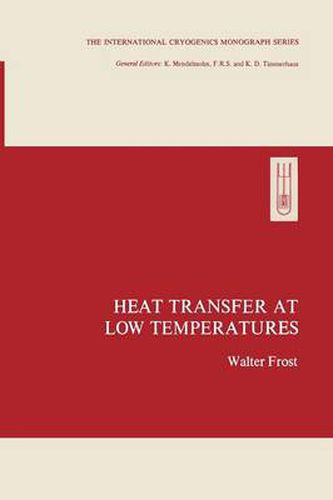Readings Newsletter
Become a Readings Member to make your shopping experience even easier.
Sign in or sign up for free!
You’re not far away from qualifying for FREE standard shipping within Australia
You’ve qualified for FREE standard shipping within Australia
The cart is loading…






This title is printed to order. This book may have been self-published. If so, we cannot guarantee the quality of the content. In the main most books will have gone through the editing process however some may not. We therefore suggest that you be aware of this before ordering this book. If in doubt check either the author or publisher’s details as we are unable to accept any returns unless they are faulty. Please contact us if you have any questions.
The purposes of this book are to provide insight and to draw attention to problems peculiar to heat transfer at low temperatures. This does not imply that the theories of classical heat transfer fail at low temperatures, but rather that many of the approximations employed in standard solutions techniques are not valid in this regime. Physical properties, for example, have more pronounced variations at low temperatures and cannot, as is conventionally done, be held constant. Fluids readily become mixtures of two or more phases and their analysis is different from that for a single-phase fluid. These and other problems which occur more frequently at low temperatures than at standard conditions are discussed in this book. Although the title specifies heat transfer, the book also contains a very comprehensive chapter on two-phase fluid flow and a partial chapter on the flow of fluids in the thermodynamically critical state. Emphasis is placed on those flow phenomena that occur at low temperatures. Flow analyses are, of course, a prerequisite to forced-convection heat transfer analyses, and thus these chapters add continuity to the text. The book is primarily written for the design engineer, but does broach many topics which should prove interesting to the researcher. For the student and teacher the book will serve as a useful reference and possibly as a text for a special topics course in heat transfer.
$9.00 standard shipping within Australia
FREE standard shipping within Australia for orders over $100.00
Express & International shipping calculated at checkout
This title is printed to order. This book may have been self-published. If so, we cannot guarantee the quality of the content. In the main most books will have gone through the editing process however some may not. We therefore suggest that you be aware of this before ordering this book. If in doubt check either the author or publisher’s details as we are unable to accept any returns unless they are faulty. Please contact us if you have any questions.
The purposes of this book are to provide insight and to draw attention to problems peculiar to heat transfer at low temperatures. This does not imply that the theories of classical heat transfer fail at low temperatures, but rather that many of the approximations employed in standard solutions techniques are not valid in this regime. Physical properties, for example, have more pronounced variations at low temperatures and cannot, as is conventionally done, be held constant. Fluids readily become mixtures of two or more phases and their analysis is different from that for a single-phase fluid. These and other problems which occur more frequently at low temperatures than at standard conditions are discussed in this book. Although the title specifies heat transfer, the book also contains a very comprehensive chapter on two-phase fluid flow and a partial chapter on the flow of fluids in the thermodynamically critical state. Emphasis is placed on those flow phenomena that occur at low temperatures. Flow analyses are, of course, a prerequisite to forced-convection heat transfer analyses, and thus these chapters add continuity to the text. The book is primarily written for the design engineer, but does broach many topics which should prove interesting to the researcher. For the student and teacher the book will serve as a useful reference and possibly as a text for a special topics course in heat transfer.